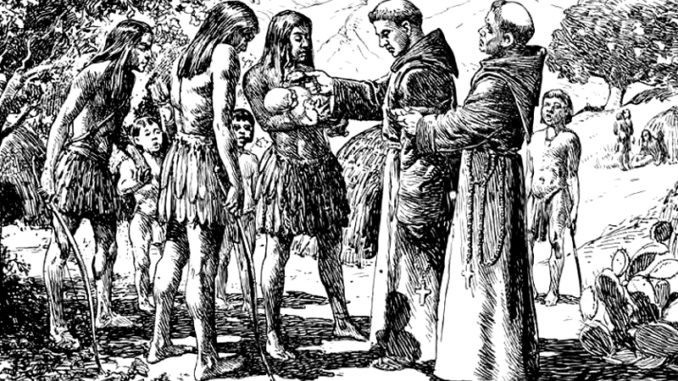
(Versión en español más abajo)
Father Diego de la Cruz was born in Spain in the first few years of the 1500s. His family was wealthy and he received a good secular education.
He traveled to the New World with the intent to acquire more wealth. He settled in La Española (Modern day Dominican Republic) and amassed a fortune by using slave, ignoring the royal edict against slavery. One Sunday he converted while attending a Mass at a Dominican Mission. He released his slaves, gave a large portion of his wealth to the local Missionaries and the rest he sent back to his family in Spain. He traveled to the Dominican convent in Tenochtitlan and joined the Order. He was ordained a priest and had a reputation of being a professor of high erudition. His elegant and persuasive style of preaching drew many souls to Church, both the educated and common people. He spent much of his time in evangelizing the Aztecs. Later in life he requested to return to Spain and spend the remainder of his life in a convent of Castile. In Spain he planned travel to the remote countrysides and offer the sacraments.
Father De La Cruz embarked with a fleet at Veracruz. The ships were intercepted by a violent hurricane and they were wrecked off the coast of Texas, near present Mansfield Cut and Padre Island. Out of the 1.000 travelers only some 304 survived, among them Father De La Cruz and four other Dominican priests. The survivors, along with 3 Dominican priests, headed south towards Veracruz. The group was forced to travel fast by constant attacks from the Karankawa, this meant they were plagued by of a lack of sleep, water, and food. Father De La Cruz was hit by several arrows while administering the last rites during an attack. He survived and managed to travel with the group until the delta of the Rio Grande River. He confessed with another surviving priest and died there in 1553. He was buried on the banks of the Rio Grande River.
Roland Flores, Traditionalist Carlist Circle Camino Real de Tejas
***
El padre Diego de la Cruz nació en España en los primeros años del siglo XVI. Su familia era acomodada y recibió una buena educación como seglar.
Viajó al Nuevo Mundo con la intención de adquirir riquezas. Se estableció en La Española (actual República Dominicana) y amasó una fortuna utilizando esclavos, ignorando el edicto real contra la esclavitud. Un domingo se convirtió mientras asistía a una misa en una misión dominicana. Liberó a sus esclavos, donó gran parte de su fortuna a los misioneros locales y el resto lo envió a su familia en España. Viajó al convento dominico de Tenochtitlán e ingresó en la Orden. Fue ordenado sacerdote y tenía fama de ser un profesor de gran erudición. Su estilo de predicación, elegante y persuasivo, atrajo a muchas almas a la Iglesia, tanto cultas como del pueblo llano. Dedicó gran parte de su tiempo a evangelizar a los aztecas. Más tarde pidió volver a España y pasar el resto de su vida en un convento de Castilla. Planeaba viajar a los campos más remotos de España y llevar allí los sacramentos.
El padre De La Cruz se embarcó con una flota en Veracruz. Los barcos naufragaron como consecuencia de un huracán muy violento frente a la costa de Texas, cerca de los actuales Mansfield Cut y Padre Island. De los 1.000 viajeros sólo sobrevivieron unos 304, entre ellos el padre De La Cruz y otros cuatro sacerdotes dominicos. Los supervivientes, junto con tres sacerdotes dominicos, se dirigieron al sur, hacia Veracruz. El grupo se vio obligado a viajar deprisa debido a los constantes ataques de los Karankawa, sufriendo por la falta de sueño, agua y alimentos. El padre De La Cruz fue alcanzado por varias flechas mientras administraba la extremaunción durante un ataque. Sobrevivió y consiguió viajar con el grupo hasta el delta del río Grande. Allí se confesó con otro sacerdote superviviente y murió en 1553. Fue enterrado a orillas del río Grande.
Roland Flores, Círculo Carlista Camino Real de Tejas




Deje el primer comentario